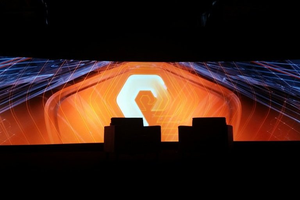Pure Storage Goes After NetApp’s Lunch With New FlashBlade

Pure Storage have launched an entirely new product line, dubbed FlashBlade, at its brand new conference Pure Accelerate.
The product was developed in a spin-out, spin-in style inspired by Cisco's approach to developing the UCS product (among others) where a new team was hired to build the product in stealth over the past two-and-a-half years. While the team was still connected to the larger Pure Storage entity, it operated at arm's length, with members not even linked to known Pure employees on sites such as LinkedIn to preserve secrecy.
The resulting product is markedly different from the existing FlashArray product line, though it shares a similar management interface. FlashBlade is a scale-out architecture running a distributed software layer on Intel CPUs on custom boards that connect to NAND chips mounted onboard, rather than in commodity SSDs. The NAND gateway is a custom ARM-chip/FPGA combination designed to provide software style flexibility to multiple vendor NAND chips, rather than having an ASIC.
Pure Storage founder John Hayes, who was part of the FlashBlade team, told analysts and bloggers that the choice of components was designed to provide low cost performance without loss of flexibility. “What we want to do is say, ‘In order to integrate a new NAND chip, what are the fewest number of components we can change?'” Hayes said. He told the group that the competitiveness of the NAND flash market meant that vendors would mean a new chip would be available once every six months, and Pure Storage wants to take advantage of that development cadence.
The design ethos for the platform was to remove components to reduce costs and to make the NAND the largest part of the bill of materials, thus helping the company to benefit from the dramatic price reductions in flash that we have observed in recent years. Customized firmware, software, and board layouts meant the company could remove complexity required to handle general purpose components with many failure modes, which reduces development costs and time-to-market.
The system also has a custom designed software-defined networking layer based on Ethernet, to remove latency introduced by complex networking stacks, and to reduce the external components required to scale. FlashBlades use a networking layer build in to the chassis for a single enclosure, and will require the use of an external switch to scale to multiple enclosures. The combined group of blades still act as a single cluster.
The system is very much a version 1.0 product, as it lacks data management features such as snapshots and a full set of protocols (the existing product is NFS only, with S3 coming soon, and others to follow later). This is deliberate, according to VP of Products Matt Kixmoeller, who told me that part of the startup mentality is to ensure that you ship a product and not spend too much time trying for perfection.

“It's really hard to build new products,” said CEO Scott Dietzen. “You have to have a supreme focus. You need to have a sense of urgency.” He believes that having new product development operating at arm's length from the main business of the company is the only way to successfully do new product development in high tech.
“By creating a level of separation you can foster higher levels of disruptive innovation,” he said. “You make sure they're not spending too much time worrying about the core business, because they need to be thinking about their new upstart business.”
This new upstart scale-out flash array is, in my opinion, positioned squarely at NetApp's bread-and-butter of engineering workloads over NFS: CAD/CAM and data analysis. Adding an S3 storage interface will open the platform up to more big-data style analysis workloads that use HDFS.
Bringing out a new product line as substantially different to the original FlashArray demonstrates that Pure Storage is a grown-up company with long-term plans, not a single product company waiting to be acquired by someone larger. If Pure can continue with the strong sales it has already demonstrated while maintaining the same discipline on costs, then there is every reason to believe the company's predictions of a move to profitability sometime in 2017.
I traveled to Pure Accelerate as a guest of Pure Storage.
This article first appeared in Forbes.com here.
